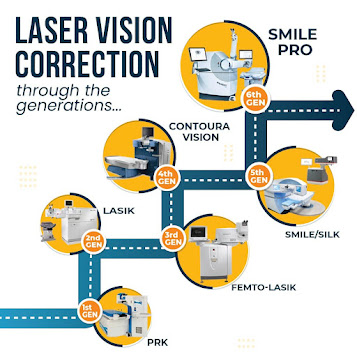Which Eye Surgery is AI (Artificial Intelligence) Based?
Explore how Artificial Intelligence (AI) is revolutionizing eye surgery, increasing precision and improving patient outcomes in ophthalmology.
AI's integration into eye surgery is primarily seen in cataract and refractive surgeries. One of the leading AI-based systems is Alcon’s LenSx laser, used for cataract surgery. This technology utilizes AI to create high-resolution images of the eye. Using these images, the machine conducts analysis and makes precise incisions, leading to improved outcomes.
Another AI-based system, Zeiss's SMILE (Small Incision Lenticule Extraction), is used in refractive surgery. SMILE uses 3D modeling and AI algorithms to make accurate corneal incisions, facilitating the correction of refractive errors like myopia and astigmatism.
AI is also used to diagnose ocular diseases that may require surgical intervention.
AI-based systems are not only making surgeries more precise but also safer. They minimize human errors and increase the predictability of surgical outcomes. Moreover, AI can potentially democratize access to high-quality surgical care, as it can be used in remote areas where experienced ophthalmologists may not be readily available. As AI technology continues to evolve, its role in ophthalmology is set to increase, benefiting patients worldwide.
Why are they considered AI-based?
These systems are considered AI-based because they utilize machine learning algorithms and advanced analytics to execute tasks that traditionally require human expertise and intervention. In the case of Alcon’s LenSx laser, the AI isn't just passively following a surgeon's orders. It actively learns from each procedure, enhancing its precision and efficiency in subsequent surgeries. The technology uses AI to analyze high-resolution images of the eye and determine the optimal points for incisions, a task that requires a high level of precision and judgment.
Similarly, Zeiss's SMILE system uses 3D modeling and machine learning algorithms to render accurate cornea maps and make precise incisions. This application of AI extends beyond the mere automation of manual tasks. The machine learning component allows the system to learn from each procedure it performs, continuously improving its precision and the predictability of outcomes.
Additionally, AI is also employed in the early diagnosis of ocular diseases. Machine learning algorithms are used to analyze images and identify subtle patterns and changes that may signify the early stages of diseases like glaucoma or diabetic retinopathy. These complex tasks require the system to "learn" from large datasets of images, improving its diagnostic accuracy over time and potentially catching diseases earlier than traditional methods.
Ultimately, AI's potential to learn, adapt, and improve over time makes these systems truly AI-based. By reducing dependency on human intervention, AI-based systems can deliver more precise and predictable outcomes, making surgeries safer and more accessible.
Is Silk Surgery AI-based?
Silk, an AI-driven robotic surgical device, is not specifically designed for eye surgery but incorporates AI to enhance surgical precision across various fields. Developed by Medtronic, Silk is a soft-tissue surgical robot designed to assist in minimally invasive procedures. It uses AI technology to provide the surgeon with improved control, enhanced vision, and greater accuracy during surgery.
AI's role in Silk is to interpret and learn from the surgeon's movements, surgical plans, and intraoperative data, allowing the robot to support and enhance the surgeon's techniques. While Silk's primary applications are currently in urology, gynecology, thoracic, colorectal, and general surgery, the scope of AI-driven surgical robots like Silk might expand to include ophthalmology in the future. As AI continues to develop, we can expect to see it integrated into more areas of medicine, providing doctors with powerful tools to improve patient outcomes.
Are these AI-based surgeries safe?
AI-based surgeries are indeed considered safe and, in many cases, can offer improved patient outcomes compared to traditional methods. These systems aim to reduce the margin of human error by standardizing surgical procedures, thereby enhancing precision and predictability.
They undergo rigorous testing and are often subject to strict regulatory approval processes to ensure patient safety. Studies have shown that AI-based systems like Alcon’s LenSx laser and Zeiss's SMILE have high safety profiles and rare complications. These technologies provide the added benefit of learning from each surgery they perform, continuously improving their accuracy.
However, like any surgical procedure, AI-based surgeries are not entirely risk-free. They still require the oversight and judgment of skilled surgeons to manage unexpected occurrences during surgery. Also, specific patient factors, such as overall health and other ocular conditions, may affect the risk level. Therefore, it's crucial for patients considering AI-based surgeries to discuss potential risks and benefits with their healthcare provider.
Which other surgeries can be termed AI-based?
Retinal Disease Diagnosis and Treatment: AI systems like Google's DeepMind can analyze retinal images to diagnose conditions such as diabetic retinopathy and age-related macular degeneration. This technology can also guide lasers for precise treatment of these conditions.
AI in Glaucoma Surgeries: With the help of AI, surgeons can predict the success rate of glaucoma surgeries like trabeculectomy. AI algorithms analyze pre-operative patient data to make these predictions, aiding in surgical planning and decision-making.
Eye Movement Correction: AI-based systems like NIDEK's NAVEX Quest can correct eye movement during Lasik surgery. The system tracks the eye's position and adjusts the laser in real time, ensuring accurate corneal reshaping.
AI in Corneal Transplants: AI algorithms can assist in the planning and execution of corneal transplants. The system analyzes the patient's eye shape and condition to determine the optimal graft size and location.
Robotic-Assisted Eye Surgery: Robotic systems like Preceyes Surgical System use AI to aid surgeons in delicate eye operations, improving precision and reducing the risk of human error.
AI in Intraocular Lens (IOL) Selection: AI algorithms can predict the most suitable IOL type for cataract patients. By analyzing patient data and past outcomes, AI can help ophthalmologists make more informed decisions, aiming to improve post-surgery vision quality.
These advances showcase the potential of AI in revolutionizing eye surgery, making procedures safer, more precise, and more accessible.




Comments
Post a Comment